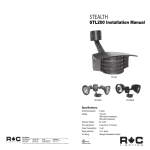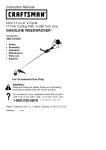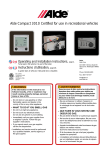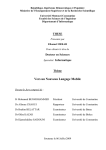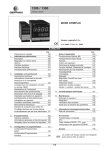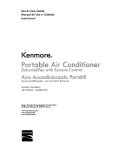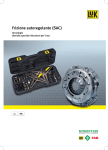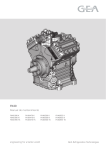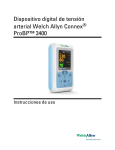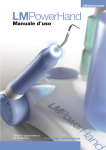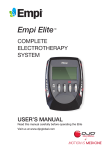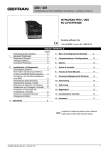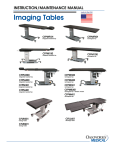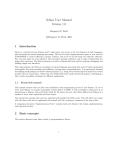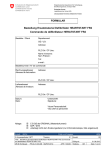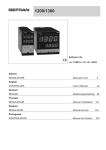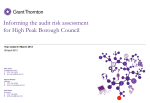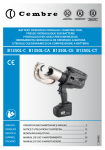Download Health Ox - Magnifying Aids
Transcript
Health Ox Fingertip Pulse Oximeter Oxymetre de Pouls Digital Oximetro de Pulso Tactil Item # 18710 DRIVE MEDICAL 99 Seaview Blvd Port Washington, NY 11050 www.drivemedical.com English Drive Health-Ox Fingertip Pulse Oximeter 3 1.Measurement principle The Oximeter displays functional oxygen saturation. The oximeter’s algorithm uses the Lambert Beer Law according to Spectrum Absorption Characteristics of Reductive hemoglobin (RHb) and Oxyhemoglobin (O2 Hb) in glow and near-infrared zones. Operation principle of the instrument is Photoelectric Oxyhemoglobin Inspection Technology is adopted in accordance with Capacity Pulse Scanning and Recording Technology, so that two beams of different wavelength of lights (660nm glow and 880nm near infrared light) can be focused onto human nail tip through perspective clamp fi nger-type sensor. Then measured signal can be obtained by a photosensitive element, information acquired through which will be shown on two groups of LEDs through process in electronic circuits and microprocessor. 2.Precautions for use • Operation of 18710 may be affected by the use of an electrosurgical unit (ESU). • The 18710 must be able to measure the pulse properly to obtain an accurate SpO2 measurement. Verify that nothing is hindering the pulse measurement before replying on the SpO2 measurement. • Do not use the 18710 in an MRI or CT environment • Do not use the 18710 in situations where alarms are required. The device has no alarms. • Explosion hazard: Do not use the 18710 in an explosive atmosphere. • The 18710 is intended only for non-medical use for healthy people to monitor their pulse and blood oxygen levels while exercising. 4 • Check the pulse oximeter sensor application site frequently to determine the positioning of the sensor and circulation and skin sensitivity of the user. • Before use, carefully read the manual. • The 18710 has no SpO2 alarms, it is not for continuous monitoring, as indicated by the symbol. • Prolonged use or the user’s condition may require changing the sensor site periodically. It is recommended that the sensor should not be applied to the same finger for over 2 hours. 3. Inaccurate measurements may be caused by • Do not sterilize the device using autoclaving, ethylene oxide sterilizing, or immersing the sensors in liquid which may cause inaccurate readings. The device is not intended for sterilization. • Signifi cant levels of dysfunctional hemoglobin’s (such as carbonxy- hemoglobin or met hemoglobin) • Intravascular dyes such as indocyanine green or methylene blue • SpO2 measurements may be adversely affected in the presence of high ambient light. Shield the sensor area from direct sunlight or indoor lighting. • Excessive user movement • High-frequency electrosurgical interference and defi brillators 5 • Venous pulsations • Placement of a sensor on an extremity with a blood pressure cuff, arterial catheter, or intravascular line • The user has hypotension, severe vasoconstriction, severe anemia, or hypothermia • The user is in cardiac arrest or is in shock • Fingernail polish or false fi ngernails may cause inaccurate SpO2 readings. • Follow local ordinances and recycling instructions regarding disposal or recycling of the device and device components, including batteries. 4. Technical Specifications Display Type: LED display - SpO2 Measurement Range: 0%-99% Accuracy: ±2%; ≤70% no defi nition. - Pulse Range Measurement Range: 30 – 250 bpm, Accuracy: ±2 bpm or±2% (select larger) for Pulse Rate. Power Requirement: Two AAA 1.5V alkaline batteries Low Consumption: Less than 25mA Measurement Accuracy: SpO2 Accuracy: ±2%; ≤70% no defi nition - No defi nition of less than 70% - Pulse rate Accuracy : ±2 bpm or±2% (select larger) for Pulse Rate. 6 The product will automatically be powered off when no signal is in the product for longer than 5 seconds. Dimension: Length: 56mm~62mm, Width: 32mm~38mm ; Weight: 45g~60g (including two AAA batteries) Environment Requirements: Operation Temperature: 50°F ~ 104°F / 10°C ~ 40°C Storage Temperature: -40°F ~ 140°F / -40°C ~ 60°C 5.Product Properties 5.1 Operation of the product is simple and convenient 5.2 The product is small in volume, light in weight (total weight is about 50g including batteries) and convenient in carrying 5.3 Power consumption of the product is low and the two originally-equipped two AAA batteries can be operated continuously for 30 hours. 5.4 Low voltage warning will be indicated in visual window when battery voltage is so low that normal operation of the Oximeter might be infl uenced. 5.5 The product will automatically be powered off when no signal is in the product for longer than 5 seconds. 7 6. Product Intended Use Intended Use: Fingertip Pulse Oximeter 18710 is a portable non-invasive, spot-check, oxygen saturation of arterial hemoglobin (SpO2) and pulse rate of adult and pediatric users at home or while exercising.Not for continuously monitoring. The 18710 requires no routine calibration or maintenance other than replacement of batteries. 7. Operation Instructions 7.1 Installing two AAA batteries into battery cassette before covering its cover. 7.2 Open the clamp as illustrated in the picture below 7.3 Plug one of fi ngers into rubber hole of the Oximeter (it is best to plug the fi nger thoroughly) before releasing the clamp 7.4 Press the switch button once on front panel. 7.5 Keep your finger and body still while taking measurements. 7.6 Read correspondent datum from display screen. 7.7 One display mode. 8 Turn on the Oximeter. Each time you press the power switch, the Oximeter will s the power switch, the Oximeter will reset the display and restart its measurements. s. our ch lse When your fi nger is plugged into the Oximeter, your nail surface must be upward. Brief Description of Front Panel User pulse quality signals are indicated as such by the amplitude of the bar graph. The higher the amplitude, SpO2the stronger the pulse signal. Pulse Column PR Power Switch 9 9. Product Accessories . Product Accessories 9.1 One Lanyard One 9.2 Lanyard Two batteries Two 9.3 batteries One instruction manual One 9.4 instruction manualboot One protective One protective boot 10. Battery Installations 0. Battery Installations 10.1two Put AAA the two AAA batteries into battery cassette in correct polarities. 1 Put the batteries into battery cassette in correct polarities. 10.2 the battery cover horizontally the arrow shown below: 2 Push thePush battery cover horizontally alongalong the arrow shown asas below: tes: Notes: polarities must correctly installed. ttery Battery polarities must bebecorrectly installed. herwise, damagedamage might be caused to device. Otherwise, might be caused to device. Please put or remove batteries in right order, or or isis ease put or remove batteries in right order, likely to damage the device bracket. ely to damage the device bracket. Please remove the battery if the Oximeter will not be ease remove battery used forthe a long time. if the Oximeter will not be ed for a long time. 11.Hang Lace Installations 1.Hang Lace Installations 11.1 Thread thinner end of the hang lace through the hanging hole. .1 Thread end ofend theof hang lacethrough through the hanging hole. 11.2 thinner Thread thicker the lace the threaded end before pulling it tightly. .2 Thread thicker end of the lace through the threaded end before pulling it tightly. 10 12. Maintenance and Storage 12.1 Replace the batteries timely when low voltage lamp is lighted 12.2 Clean surface of the fi ngertip Oximeter before it is used 12.3 Remove the batteries inside the battery cassette if the Oximeter will not be operated for a long time 12.4 It is best to preserve the product in a place where ambient temperatures –40~60°C (- 40~140°F) and humidity is ≤95% It is recommended that the product should be kept in a dry environment. Wet ambient might affect its lifetime and even might damage the product. Cleaning the 18710 Clean inside of Oximeter with a soft cloth dampened with 70% isopropyl alcohol. Clean the test fi nger using alcohol before and after each test. Do not pour or spray and liquids onto the Oximeter. Do not allow any liquid to enter any openings in the device. Allow the Oximeter to dry thoroughly before reusing. 13. Calibrating the 18710 • The functional tester cannot be used to assess the accuracy of the Oximeter. • The test methods used to establish the SpO2 accuracy is clinical testing. The oximeter used to measure the arterial hemoglobin oxygen saturation levels and these levels are to be compared to the levels determined from arterial blood sampling with a CO-oximeter. 11 14. Possible Problems and resolutions Problems Possible Reason Solution SpO2% or pulse rate can not be shown normally 1. Finger is not plugged correctly 2. User’s SpO2 value is too low to be measured 1. Retry by plugging the finger 2. There is excessive illumination 3. Measure more times, If you can make sure about no problem existing in the product. Please go to a hospital timelyfor exact diagnosis SpO2% or pulse rate is shown unstably 1. Finger might not be plugged deep enough 2. Excessive user movement 1. Retry by plugging the fi nger 2. Be calm. The Monitor can not be powered on 1. No battery or low power of battery 2. Battery might be installed incorrectly 3. The Monitor might be damaged 1. Please replace battery 2. Please reinstall the battery 3. Please contact with local customer service centre Indication is suddenly off 1. The Oximeter is automatically powered off when no signal is detected longer than 5 seconds 2. The batteries power is too low to work 1. Normal 2. Replace the battery 12 15. Declaration Guidance and Manufacture’s declaration – electromagnetic emissionsFor all EQUIPMENT and SYSTEMS Guidance and Manufacture’s declaration - electromagnetic emission Guidance and Manufacture’s declaration – electromagnetic environment specifi ed below. The customer or the user of the Pulse Oximeter (18710) should assure that it is used in such an environment. Emission test Compliance Electromagnetic Environment – guidance RF emissions CISPR 11 Group 1 The pulse Oximeter (18710) uses RF energy only for very low and is not likely to cause interference in nearby electronic equipment. RF emissions CISPR 11 Class B Harmonic emissions IEC 61000-3-2 Not Applicable Voltage fl uctuations/ flicker emissions IEC 61000-3-2 Not Applicable The pulse Oximeter (18710) is suitable for use in all establishments, including domestic establishments and those directly connected to the public low-voltage power supply network that supplies buildings used for domestic purposes. 13 Guidance and Manufacture’s declaration – electromagnetic immunityFor all EQUIPMENT and SYSTEMS Guidance and Manufacture’s declaration - electromagnetic immunity Guidance and Manufacture’s declaration – electromagnetic environment specifi ed below. The customer or the user of the Pulse Oximeter (18710) should assure that it is used in such an environment. Immunity test IEC 60601 test level Compliance Level Electromagnetic Environment – guidance Electrostatic Discharge (ESD) IEC 61000-4-2 +/- 6kV contact +/- 8kV air +/- 6kV contact +/- 8kV air Floors should be wood, concrete or ceramic tile. If fl oor are covered with synthetic material, the relative humidity should be at least 30%. Power frequency (50/60 Hz) magnetic fi eld IEC 61000-4-8 3A/m 3A/m Power frequency magnetic fields should be at levels characteristics of a typical location in a typical commercial or hospital environment. 14 Guidance and Manufacture’s declaration – electromagnetic immunityFor all EQUIPMENT and SYSTEMS that are not LIFE-SUPPORTING Guidance and Manufacture’s declaration - electromagnetic immunity Guidance and Manufacture’s declaration – electromagnetic environment specifi ed below. The customer or Guidance and Manufacture’s declaration – electromagnetic immunitythe user of the Pulse Oximeter (18710) should assure that thatare it isnotused in such an environment. For all EQUIPMENT and SYSTEMS LIFE-SUPPORTING Guidance and Manufacture’s declaration – electromagnetic immunity For all EQUIPMENT and SYSTEMS that are not LIFE-SUPPORTING Guidance and Manufacture’s declaration - electromagnetic immunity Immunity Guidance IEC 60601 Compliance Electromagnetic and Manufacture’s declaration – electromagnetic environment speci ed below. The customer or Environment – guidance Guidance and Manufacture’s declaration - electromagnetic immunity thetest userlevel of the Pulse Oximeter (18710) should assure that it is used in such an environment. test Level Guidance and Manufacture’s declaration – electromagnetic environment specied below. T the user of the Pulse Oximeter (18710) should assure that it is used in such an environmen Compliance IEC 60601 Immunity Portable and mobile RF communications equipment should be used no Electromagnetic Environment – guidance Level test level test Compliance IECof 60601 Immunity closer to any part thecommunications Pulse Oximeterequipment (18710),should including Radiated 3 V/m 3 V/m Electromagnetic Environment – gu Portable RF be cables, than Level test level test and mobile 3 V/m used no closer to any part of the Pulse Oximeter (18710), including Radiated the recommended separation distancePortable calculated from ap- equipme mobilethe RF equation communications RF 80 MHz to cables, than the3 recommended separation distanceand calculated RF80 MHz to 3 V/m V/m used to any part of the Pulse Oximeter ( Radiated plicable toequation the frequency oftothe 2.5 GHz from the thetransmitter. frequency of no thecloser transmitter. IEC 80 applicable MHz to IEC 2.5 GHz cables, than the recommended separation distanc RF 3 V/m Recommended separation distance 61000-4-3 Recommended separation distance 2.5 GHz from the equation applicable to the frequency of th IEC 61000-4-3 d= Recommended separation distance MHz to 800 MHzMHz P 8080 61000-4-3 MHz to 800 d= P 80 MHz to 800 MHz 800 MHz to 2.5 d= MHz to 2.5 GHzGHz P 800 d= 800transmitter MHz P Where themaximum maximum output power rating of theof transmitter in to 2.5 GHz Where P Pis isthe output power rating the in watts (W) according to the transmitter manufacturer and d is the Where thedmaximum output power rating of th (W)watts according toseparation the transmitter manufacturer and is the recommended recommended distance in metres (m). P is watts (W) according to the transmitter manufacture Field strengths from xed RF transmitters, as determined by an separation distance in metres (m). Fieldrecommended strengths from fixed RFdistance transmitseparation in metres (m). electromagnetic site survey a, should be less than the compliance Fieldsite strengths xed RFbe transmitters, ters, as indetermined by an electromagnetic surveyfrom a, should less than as dete b level each frequency range. a electromagnetic site be less than maylevel occur ineach the vicinity of equipment marked withsurvey , should theInterference compliance in frequency range. b b level in each frequency range. following symbol: may occur inwith the vicinity of equipmen Interference may occur in the vicinity ofInterference equipment marked following symbol: NOTE 1: At 80 MHz and 800 MHz, thefollowing higher frequency symbolrange applies. NOTE 2: These guidelines may not apply in all situations, Electromagnetic propagation is affected by 3.5 E1 7 E1 3.5 E1 7 E1 NOTE 1: Atand 80 MHz and 800 MHz, the higher frequency range applies. absorption and reection structures, objects people. NOTE 2: These guidelines may not apply in all situations, Electromagnetic propagation is a NOTE 1: At 80 MHz and 800 MHz, the higher frequency applies. reection structures, objects and people. - absorption 12 -rangeand NOTE 2: These guidelines may not apply in all situations, Electromagnetic propagation - 12is-affected by absorption and refl ection structures, objects and people. 15 a Field strengths from fi xed transmitters, such as base station for radio (cellular/cordless) telephones and land mobile radios, amateur radio, AM and FM radio broadcast and TV broadcast cannot be predicted theoretically with accuracy. To assess the electromagnetic environment due to fi xed RF transmitters, an electromagnetic site survey should be considered. If the measured fi eld strength in the location in which the Pulse Oximeter (18710) should be observed to verify normal operation. If abnormal performance is observed, additional measurements may be necessary, such as reorienting of the relocating the Pulse Oximeter (18710). b Over the frequency range 150 kHz to 80 MHz, fi elds strengths should be less than 3 V/m a Field astrengths Field strengths from xed from transmitters, xed transmitters, such assuch baseas station base for station radiofor (cellular/cordless) radio (cellular/cordless) telephones telephones and and land mobile land radios, mobile amateur radios, amateur radio, AM radio, andAM FMand radio FM broadcast radio broadcast TV and broadcast TV broadcast cannot be cannot predicted be predicted t t Recommended separation distances between portable andand mobile communications heoretically heoretically with accuracy. with accuracy. To assess To assess the electromagnetic the electromagnetic environment environment due RF to due xed to RFxed transmitters, RF transmitters, an equipment an electromagnetic electromagnetic site survey site should survey be should considered. be considered. If the measured If theSYSTEMS measured eld strength that eld strength inare the location in the location in whichin which and the EQUIPMENT or SYSTEMS -For all EQUIPMENT and not LIFE-SUPPORTING the Pulse theOximeter Pulse Oximeter (18710)(18710) should be should observed be observed to verifytonormal verify operation. normal operation. If abnormal If abnormal performance performance is is observed, observed, additional additional measurements measurements may be may necessary, be necessary, such assuch reorienting as reorienting of the relocating of the relocating the Pulse the Pulse Oximeter Oximeter (18710).(18710). Recommended separation distances between portable and mobile RF communications equipment b Over btheOver frequency the frequency range 150 range kHz150 to 80 kHz MHz, to 80elds MHz,strengths elds strengths should be should less be than less 3 V/m than 3 V/m and Pulse Oximeter (18710) Recommended Recommended separation separation distances distances between between portable portable and mobile and mobile RF communications RF communications equipment equipment The Pulse and Oximeter (18710) is intended for use in all electromagnetic environment in not which radiated RF theand EQUIPMENT the EQUIPMENT or SYSTEMS or SYSTEMS -For all-For EQUIPMENT EQUIPMENT and SYSTEMS and SYSTEMS that arethat notare LIFE-SUPPORTING LIFE-SUPPORTING Recommended Recommended separation distances distances between between disturbances are controlled. The customer orRFthe user separation of the Pulse Oximeter (18710) can help prevent portableportable and mobile and RF mobile communications communications equipment equipment and Pulse andOximeter Pulse Oximeter (18710)(18710) electromagnetic interference by maintaining a minimum distance between portable and mobile RF The Pulse TheOximeter Pulse Oximeter (18710)(18710) is intended is intended for use in forelectromagnetic use in electromagnetic environment environment in whichinradiated which radiated RF RF disturbances disturbances are controlled. are(transmitters) controlled. The customer The customer or the user orPulse the of the user Pulse of theOximeter Pulse Oximeter (18710) can helpcan prevent help prevent communications equipment and the Oximeter (18710) as(18710) recommended below, electromagnetic electromagnetic interference interference by maintaining by maintaining a minimum a minimum distancedistance betweenbetween portableportable and mobile and RF mobile RF according to the maximum output power of the communications equipment. communications communications equipment equipment (transmitters) (transmitters) and theand Pulse theOximeter Pulse Oximeter (18710)(18710) as recommended as recommended below, below, according according to the maximum to the maximum output power outputofpower the communications of the communications equipment. equipment. Rated maximum outputoutput output Separation distance according tofrequency frequency of(m) transmitter (m) Separation Separation distance distance according according to frequency to of transmitter of transmitter (m) Rated maximum Rated maximum power ofpower transmitter of transmitter (W) (W) power of transmitter (W) 80 MHz80 to MHz 800 MHz to 800 MHz d= E7 d=P E7 800PMHz 800 to MHz 2.5 GHz toto 2.52.5 GHz d= 3.5 d=P 3.5 800 MHz GHz E E 80PMHz to 800 MHz 1 0.01 0.1 1 10 100 0.01 0.01 0.1 1 0.1 1 10 100 10 100 1 1 0.11670.1167 0.1167 0.36890.3689 0.3689 1.1667 1.1667 1.16673.6893 3.6893 3.689311.666711.6667 11.6667 1 0.2334 0.2334 - 13 -- 13 - 0.2334 0.7378 0.7378 0.7378 2.3334 2.3334 2.3334 7.3786 7.3786 7.3786 23.3334 23.3334 23.3334 16 Fortransmitters transmittersrated rated at aamaximum not listed above, the recommended sepratation For maximumoutput outputpower power not listed above, the recommended sepratation distance distance in metres (m)estimated can be estimated using the equation applicable the frequency of the transmitter, d in metresd (m) can be using the equation applicable to thetofrequency of the transmitter, where P For transmitters rated at a maximum output power not listed above, the recommended sepratation distance is where the maximum output power ofrating the transmitter in wattsin(W) to thetotransmitter manufacturer P is the maximum outputrating power of the transmitter wattsaccording (W) according the transmitter d in metres (m) can be estimated using the equation applicable to the frequency of the transmitter, where P NOTE 1 At 80 MHz 800rating MHz,ofthe for according the highertofrequency rangemanufacturer. applies. is manufacturer. the maximum outputand power theseparation transmitter distance in watts (W) the transmitter NOTE These guidelines may the not separation apply in alldistance situations. Electromagnetic propagation is affected by NOTE21 At 80 MHz and 800 MHz, for the higher frequency range applies. NOTE 1 At 80 MHz and 800 MHz, the separation distance for the higher frequency range applies. absorption and re ection from structures, objects and people. NOTE 2 These guidelines may not apply in all situations. Electromagnetic propagation is affected by NOTE 2 These guidelines may not apply in all situations. Electromagnetic propagation is affected by absorption and refland ection objects objects and people. absorption refrom ectionstructures, from structures, and people. ansmitters rated at a maximum output power not listed above, the recommended sepratation distance etres (m) be estimated using the equation applicable to the frequency of the transmitter, where P 16.can Symbol Defi nitions 16. Symbol maximum output powerDefinitions rating of the transmitter in watts (W) according to the transmitter manufacturer. 16. Symbol Definitions 1 At 80 MHz and 800 MHz, the separation distance for the higher frequency range applies. Symbol Symbol 2 These guidelines may not apply De in allnition situations. Electromagnetic propagation is affected by Denition Symbol Definition SymbolDefinition nition objects and people.Symbol Denition Symbol absorption and reection from De structures, Low power indication No for continuous monitoring Theequipment equipment type type is BF The is BF The equipment type is BF Symbol Definitions Refertotouser usermanual manual Refer DeRefer nition to user manual before application before application before application mbol pO2% Low power indication Denition No for continuous monitoring Low indication No forpower continuous monitoring Symbol Low power indication SN SN Serial No. SerialSerial No. No. The equipment type is BF Hemoglobin saturation Hemoglobin saturation Hemoglobin saturation SpO2% 2% SpO Refer to user manual pulserate rate (bpm) pulse (bpm) Pulse rate (bpm) PRbpm bpm application PR before Hemoglobin saturation pulse rate (bpm) No for continuous of Manufacture Date Date ofmonitoring Manufacture Date of Manufacture SN - 14 - - 14 Serial No. 17 2 Year Limited Warranty Your Drive brand product is warranted to be free of defects in materials and workmanship for two years of the original consumer purchaser. This device was built to exacting standards and carefully inspected prior to shipment. This 2 year Limited Warranty is an expression of our confi dence in the materials and workmanship of our products and our assurance to the consumer of years of dependable service. In the event of a defect covered by this warranty, we will, at our option, replace the device. This warranty does not cover device failure due to owner misuse or negligence, or normal wear and tear. If you have a question about your Drive device or this warranty, please contact an authorized Drive dealer. 18 Français Drive Health-Ox Oxymètre de pouls digital 19 1. Principe de fonctionnement Cet oxymètre permet d’affi cher le taux de saturation d’oxygène fonctionnel. Le principe de l’oxymètre est le suivant : les calculs sont effectués à l’aide d’une formule empirique basée sur la loi de Lambert Beer portant sur les caractéristiques d’absorption de spectre de l’hémoglobine (R-Hb) et de l’oxyhémoglobine (O2-Hb) dans la gamme visible et proche infrarouge. Le principe de fonctionnement de l’appareil repose sur la technologie de l’analyse photoélectrique de l’oxyhémoglobine, et e le mesure de leur absorption par le fl ux pulsatile du sang. Deux faisceaux de différentes longueurs d’onde (660 nm visible, 880 nm infrarouge) dirigés sur un ongle humain et lus par un capteur situé dans une pincette dans laquelle on insère un doigt. Le résidu spectral peut être lu par une cellule photosensible, et le résultat du calcul est affi ché à l’aide de deux groupes de segments sur un écran ACL après traitement par des circuits électroniques et un microprocesseur. 2. Précautions pour l’utilisation • L’appareil 18710 peut être affecté par l’utilisation d’un appareil électrochirurgical (ESU). • L’appareil 18710 doit pouvoir mesurer le pouls correctement afi n de calculer une valeur exacte de SpO2. Assurez-vous que la mesure du pouls est correcte avant de vous fi er aux mesures de SpO2. • N’utilisez pas l’appareil 18710 dans un environnement d’IRM ou de TD • N’utilisez pas l’appareil 18710 lorsqu’un mécanisme d’alarme est requis. Cet appareil ne comporte pas d’alarme. and blood oxygen levels while exercising. 20 • Risque d’explosion : n’utilisez pas l’appareil 18710 dans une atmosphère explosive. • Les 18710 sont seulement pour l’utilisation non-medicale pour les gens en bonne sante controller leurs niveaus d’oxygene de snag et de pouls en exercant. • Examinez le site d’application de l’oxymètre fréquemment afi n d’évaluer la position de l’appareil, la circulation sanguine et l’état de l’épiderme du utilisateur. • Lisez attentivement le guide avant d’utiliser l’appareil. • L’appareil 18710 ne comporte pas de système d’alarme. Il n’est pas prévu pour une surveillance continue, comme en témoigne le symbole. • Une utilisation prolongée ou l’état du utilisateur peut exiger que l’appareil soit déplacé régulièrement. Pour la lecture par sonde d’oxymétrie, il est conseillé de changer de doigt toutes les 2 heures. 3. Facteurs pouvant induire des erreurs de mesure • • Ne stérilisez pas l’appareil à l’autoclave, à l’aide d’oxyéthylène ou par immersion dans un liquide, car ceci pourrait fausser les résultats. L’appareil ne doit pas être stérilisé. • Un taux élevé d’hémoglobine dysfonctionnelle (comme la carboxyhémoglobine ou la méthémoglobine). • Des colorants vasculaires comme le vert d’indocyanine ou le bleu de méthylène. • La mesure de SpO2 peut être faussée en présence d’un éclairage ambiant intense comme la lumière directe du soleil. Protegez le detecteur area de la lumiere du soleil directe ou de l’eclairage en sale. • Des mouvements excessifs de la part du utilisateur. • Des interférences à haute fréquence provenant d’un appareil électrochirurgical ou d’un défi brillateur. • Un pouls veineux. • L’installation de l’appareil sur un doigt avec présence d’un brassard de sphygmomanomètre, un cathéter artériel ou intravasculaire. • Le utilisateur souffre d’hypotension, de vasoconstriction, d’anémie sévère ou d’hypothermie. • Le utilisateur est en arrêt cardiaque ou en état de choc. • Le vernis à ongles et les faux ongles peuvent causer des erreurs de lecture de SpO2. • Respectez les lois et règlements concernant de dépôt aux ordures et le recyclage de l’appareil et de ses composants, incluant les piles. 4. Spécifi cations techniques Afficheur: DEO (LED) - Plage de mesure SpO2 : 0 % à 99 %, précision : ±2%; ≤70% pas de défi nition. - Plage de mesure du pouls : 30 à 250 bpm, précision : ±2 bpm ou ±2 % pour la fréquence du pouls (prendre la plus grande des deux lectures). Alimentation: Deux piles alcalines de type AAA 1,5 V Faible consommation: Moins de 25 mA Précision des mesures: Précision SpO2 :±2% ; ≤70% pas de défi nition Aucune défi nition inférieure à 70 % Pouls : ±2 bpm ou ±2 % pour la fréquence du pouls (prendre la plus grande des deux lectures). 21 22 L’appareil se met automatiquement hors tension s’il ne reçoit aucun signal pendant 5 secondes. Dimension: Longueur : 56mm~62mm; largeur : 32mm~38mm ; Poids : 45g~60g (incluant les deux piles AAA) Environment: Utilisation: 50°F ~ 104°F / 10°C ~ 40°C Entreposage: -40°F ~ 140°F / -40°C ~ 60°C 5. Caractéristiques de l’appareil 5.1 L’appareil est pratique et facile à utiliser. 5.2 L’appareil est petit et léger (50 g incluant les piles) et facile à transporter. 5.3 Il consomme peu d’énergie : les deux piles AAA originales permettent une utilisation continue de 30 heures. 5.4 L’affi cheur comporte un avertissement de pile faible qui apparaît lorsque le voltage est bas au point de compromettre la lecture de l’oxymètre. 5.5 L’appareil se met automatiquement hors tension s’il ne reçoit aucun signal pendant plus de 5 secondes. 23 6. Utilisation préconisée Utilisation préconisée: L’oxymètre de pouls digital 18710 permet d’effectuer des lectures momentanées non invasives du taux de saturation de l’hémoglobine artérielle (SpO2) et du pouls d’un enfant ou d’un adulte les utilisateurs a maison ou en exercant. Non prévu pour une utilisation continue. L’appareil 18710 ne requiert aucun calibrage ou entretien périodique autre que le remplacement des piles. 7. Instructions pour l’utilisation de l’appareil 7.1 Insérez deux piles AAA dans le compartiment et reposez le couvercle. 7.2 Ouvrez la pince comme dans l’illustration qui suit. 7.3 Placez un doigt dans le compartiment caoutchouté de l’oxymètre (il vaut mieux insérer le doigt complètement avant de refermer la pince. 7.4 Appuyez une fois sur l’interrupteur qui se situe sur la face supérieure. 7.5 Il faut que votre doigt ne tremble pas et il est recommandé de ne pas se déplacer pendant la lecture. 7.6 Relevez les données sur l’affi cheur de l’appareil. 7.7 1 mode d’affi chage. 24 Mettez l’oxymètre sous tension. Chaque fois que vous appuyez sur l’interrupteur, l’oxymètre bascule vers le prochain mode d’affi chage. Il y a deux modes d’affi chage. the power switch, the Oximeter will ur h se Le rétroéclairage est réglé au niveau 4 par défaut. Votre ongle doit se trouver du côté de l’affi cheur lorsque vous insérez votre doigt dans l’oxymètre. 8. Description du panneau de commande Pa Un diagramme à barreSpO la qualité du pouls. La barre comporte dix niveaux. 2 Une qualité de lecture de pouls est jugée inadéquate si la barre indique le niveau Pulse Column deux ou trois. PR Power Switch 25 9. Accessoires Product Accessories 9.1 Une dragonne One 9.2 Lanyard Deux piles Two 9.3 batteries Un guide d’utilisation One 9.4 instruction manual Un étui protecteur One protective boot 10. Installation des piles . Battery Installations 10.1two Insérez deux piles de battery type AAAcassette dans le compartiment en respectant la polarité. Put the AAAlesbatteries into in correct polarities. 10.2 couvercle horizontalement, dans le sens des fl as èches, comme indiqué : Push thePoussez batterylecover horizontally along the arrow shown below: es: Nota: polarité desmust piles doit respectée, au risque tery La polarities be être correctly installed. erwise, damage might be caused to device. d’endommager l’appareil. Placez piles dans le bon ordre, au risque ase put or les remove batteries in right order, or is d’endommager les supports de piles. y to damage the device bracket. Veuillez retirer les piles si l’oxymètre n’est pas utilisé se remove the Oximeter will not be pendantthe unebattery périodeifprolongée. d for a long time. 11. Installation de la dragonne .Hang Lace Installations 11.1 Passez la partie fi ne de la dragonne dans le trou. 1 Thread of plus the hang the hanging hole. 11.2 thinner Passez laend partie grosselace de lathrough dragonne dans l’anneau constitué par la partie fi ne 2 Thread thicker et tirez. end of the lace through the threaded end before pulling it tightly. 26 12. Entretien et remisage 12.1 Remplacez les piles promptement lorsque l’indicateur de pile faible apparaît. 12.2 Nettoyez les surfaces de l’oxymètre avant de l’utiliser. 12.3 Retirez les piles du compartiment si l’oxymètre n’est pas utilisé pendant une période prolongée 12.4 Il est préférable de conserver l’appareil à une température ambiante entre -40 °C et 60 °C (-40 °F à 140 °F) et une humidité ambiante entre ≤95%. Il est préférable de conserver l’appareil dans un environnement sec. Un environnement humide peut endommager l’appareil ou réduire sa durée de vie. Nettoyage de l’appareil 18710 Nettoyez l’intérieur de l’oxymètre à l’aide d’un chiffon doux mouillé d’alcool isopropylique à 70 %. Nettoyez le doigt qui servira au test à l’aide d’alcool avant et après chaque test. Ne vaporisez pas et ne versez pas de liquide sur l’oxymètre. Ne laissez aucun liquide pénétrer par les ouvertures de l’oxymètre. Laissez sécher l’oxymètre parfaitement avant de le réutiliser. 13. Calibration de l’appareil 18710 • Les appareils de tests fonctionnels ne peuvent pas être utilisés pour évaluer la précision de l’oxymètre. • La méthode utilisée pour évaluer la précision des mesures de SpO2 est le test clinique. Les données de l’oxymètre concernant taux de saturation en oxygène de l’hémoglobine artérielle sont comparables aux données obtenus par échantillonnage sanguin et traitées à l’aide d’un CO-oxymètre. 27 14. Dépannage Problème Cause possible Solution % SpO2 ou le pouls n’est pas affi ché normalement 1.Le doigt n’est pas placé correctement 2.Le SpO2 du utilisateur est trop faible pour être mesuré 1.Replacez le doigt 2.L’éclairage ambiant est trop fort 3.Effectuez d’autres lectures pour vous assurer que l’appareil fonctionne bien. Consultez un professionnel de la santé rapidement afi n d’obtenir un diagnostic formel L’affi chage du % SpO2 ou du pouls est instable 1.Le doigt n’est pas inséré assez profondément 2.Mouvements excessifs 1. Repositionnez le doigt 2. Soyez plus calme L’affi cheur ne s’allume pas 1.Piles absentes ou trop faibles 2.Piles mal insérées 3.Appareil endommagé 1. Remplacez les piles 2. Réinstallez les piles 3. Communiquez avec le service à la clientèle L’affi cheur s’éteint soudainement 1.L’appareil se met hors tension s’il ne détecte aucun signal pendant 5 secondes 2.Les piles sont trop faibles 1. Normal 2. Remplacez les piles 28 15. Déclaration Émissions électromagnétiques – recommandations et déclarations du fabricant Pour tous les ÉQUIPEMENTS et SYSTÈMES Émissions électromagnétiques – recommandations et déclarations du fabricant Les recommandations et déclarations du fabricant concernant l’environnement électromagnétique apparaissent dans ce tableau. Le client ou l’utilisateur de l’oxymètre de pouls digital (18710) doit s’assurer qu’il est utilisé dans un tel environnement. Test d’émissions Conformité Recommandations sur l’environnement électromagnétique Émissions RF CISPR 11 Groupe 1 L’oxymètre de pouls (18710) ne produit que de très faiblesémissions RF et ne nuira à aucun équipement à proximité. Émissions RF CISPR 11 Classe B Émissions harmoniques IEC 61000-3-2 Sans objet L’oxymètre de pouls (18710) Cet appareil est prévu pour une utilisation dans tous les types d’établissements, y compris les établissements domestiques et ceux branchés directement au réseau public d’alimentation électrique à basse tension Fluctuations de tension / papillotements IEC 61000-3-2 Sans objet 29 Immunité électromagnétique – recommandations et déclarations du fabricant Pour tous les ÉQUIPEMENTS et SYSTÈMES Immunité électromagnétique – recommandations et déclarations du fabricant Les recommandations et déclarations du fabricant concernant l’environnement électromagnétique apparaissent dans ce tableau. Le client ou l’utilisateur de l’oxymètre de pouls digital (18710) doit s’assurer qu’il est utilisé dans un tel environnement. Recommandations – environnement Test d’immunité Niveau de test Conformité électromagnétique IEC 60601 Electrostatic Discharge (ESD) IEC 61000-4-2 ±6 kV contact ±8 kV air +/- 6kV contact +/- 8kV air Le plancher doit être recouvert de bois, de béton ou de céramique. Si le plancher est recouvert de matériel synthétique, l’humidité relative doit être d’au moins 30 %. Champs magnétiques à la fréquence du réseau (50/60 Hz) IEC61000-4-8 3A/m 3A/m Les champs magnétiques du réseau de distribution doivent correspondre à ceux d’un environnement hospitalier ou commercial typique. 30 Immunité électromagnétique – recommandations et déclarations du fabricant Pour tous les ÉQUIPEMENTS et SYSTÈMES non reliés au MAINTIEN DE LA VIE Immunité électromagnétique – recommandations et déclarations du fabricant Les recommandations et déclarations du fabricant concernant l’environnement électromagnétique apparaissent dans ce Guidance and Manufacture’s declaration – electromagnetic immunitytableau. Le client ou l’utilisateur deand poulsSYSTEMS digital (18710) doit s’assurer qu’il est utilisé dans un tel environnement. Forde alll’oxymètre EQUIPMENT that are not LIFE-SUPPORTING Guidance and Manufacture’s declaration – electromagnetic immunityFor all EQUIPMENT and SYSTEMS that are not LIFE-SUPPORTING and Manufacture’s declaration - electromagnetic immunity Test Niveau de Guidance Conformité Guidance and Manufacture’s declaration – electromagnetic environment specied below. The customer or Conformité Electromagnetic – guidance Guidance andEnvironment Manufacture’s declaration - electromagnetic immunity user the Pulse Oximeter (18710) should assure that it is used in such an environment. d’immunitéthetest IECof60601 Guidance and Manufacture’s declaration – electromagnetic environment specied below. Th the user of the Pulse Oximeter (18710) should assure that it is used in such an environment Immunity IEC 60601 ComplianceLes équipements portables et mobiles à RF doivent être utilisés à une Electromagnetic Environment – guidance Level test level test Compliance IECde 60601 Immunity certaine distance toutes les composantes de should l’oxymètre de pouls digital – guid RF par 3 V/m 80 3 V/m Electromagnetic Environment Portable RF communications equipment be Level test level test and mobile 3 V/m used no to any of the Oximeter (18710),est including Radiated (18710), y closer compris lespart câbles. LaPulse distance minimale calculée à l’aide de equipmen mobile RF communications rayMHz 80 MHz to cables, than the recommended separationPortable distanceand calculated RF 3 V/m 3 V/m used no closer to any part of the Pulse Oximeter (18 Radiated l’équation correspondant à la fréquence du transmetteur. 2.5 GHz from the equation to the frequency of the transmitter. 80 applicable MHz to onnement IEC à 2,5 GHz cables, than the recommended separation distance RF 3 V/m Recommended separation 61000-4-3 Distance 2.5 GHz : distance from the equation applicable to the frequency of the IEC recommandée IEC d= MHz to 800 MHz P 8080 61000-4-3 MHz à 800 MHz Recommended separation distance d= P 80 MHz to 800 MHz 61000-4-3 800 MHz à 2,5 GHz d= MHz to 2.5 GHz P 800 OùWhere P est la puissance de sortie maximaled=du transmetteur, en watts (W) 800 MHz P is the maximum output power rating of the Ptransmitter in to 2.5 GHz selon le(W) fabricant dutotransmetteur d est la distance en watts according the transmitteret manufacturer and d isrecommandée the Where P is the maximum output power rating of the recommended separation distance in metres (m). mètres (m). (W) according Field strengths from xed RF transmitters, watts as determined by anto the transmitter manufacturer recommended separation distance in metres (m). a site survey , should be less than theRF compliance La electromagnetic force des champs émis par les transmetteurs fi xes, telle Field strengths from xed RF transmitters, as determ in each frequency range. b electromagnetic quelevel mesurée sur leoccur siteina,the doitvicinity être inférieure aumarked niveausite desurvey a, should be less than t Interference may of equipment with b level in each frequency range. following symbol: conformité dans chaque gamme de fréquenceb. Interference may occur in the vicinity of equipment m following symbol:immédiats interférences peuvent survenir dans les environs NOTE 1: At 80 MHz and 800 MHz, theDes higher frequency range applies. NOTE 2: These guidelines may not apply in all situations, Electromagnetic propagation is affected by des appareils ce800 symbole NOTE 1: Ataffi 80 chant MHz and MHz, the higher frequency range applies. 3.5 E1 7 E1 3.5 E1 7 E1 absorption and reection structures, objects and people. NOTE 2: These guidelines may not apply in all situations, Electromagnetic propagation is aff NOTA 1: À 80 MHz et 800 MHz, on doit considérer la plus gamme de fréquences. and reection structures, objects and people. - absorption 12haute NOTE 2: Ces recommandations peuvent ne pas s’appliquer à toutes les situations. La propagation des champs - 12 électromagnétiques est affectée par l’absorption et la réfl exion des objets, des structures et des individus présents. 31 a La force des champs émis par les transmetteurs fi xes comme les antennes émettrices des fournisseurs de services pour les téléphones cellulaires et sans fi l et les appareils radio, radio amateur, AM, FM et de télédiffusion ne peuvent être prédits sur une base théorique avec exactitude. L’environnement électromagnétique imputable aux transmetteurs RF fi xes ne peut donc être mesuré que sur le site. Si les champs magnétiques mesurés dans l’environnement d’utilisation de l’oxymètre de pouls digital (18710) sont supérieurs aux niveaux de conformité mentionnés plus haut, on doit observer le fonctionnement de l’appareil pour déterminer s’il est affecté ou non par la situation. Si on observe une performance anormale, on devra prendre des dispositions particulières comme le changement d’orientation ou d’emplacement de l’oxymètre de pouls digital (18710). astrengths b Au delà dea laField gamme fréquences 150transmitters, kHzsuch to 80asMHz, labase forcefor des champs magnétiques doit être moins Fieldde strengths from xed from transmitters, xed such baseas station station radio for (cellular/cordless) radio (cellular/cordless) telephones telephones and and de 3 V/m land mobile land radios, mobile amateur radios, amateur radio, AM radio, andAM FMand radio FM broadcast radio broadcast and TV and broadcast TV broadcast cannot be cannot predicted be predicted t t heoretically heoretically with entre accuracy. with accuracy. assess To assess the electromagnetic thede electromagnetic environment environment dueàtoRF due xed to RFxed transmitters, RF et transmitters, anÉQUIPEMENTS an Distance recommandée lesToéquipements communication portables ces electromagnetic electromagnetic site survey site should survey be should considered. be considered. If the measured If the measured eld strength eld strength in the location in the location in whichin which ou SYSTÈMES ÉQUIPEMENTS etbeSYSTÈMES nonoperation. reliésoperation. au MAINTIEN DE LAisVIE is thePour Pulse thetous Oximeter Pulseles Oximeter (18710) (18710) should be should observed observed to verifytonormal verify normal If abnormal If abnormal performance performance observed, observed, additional additional measurements measurements may be may necessary, be necessary, such assuch reorienting as reorienting of the relocating of the relocating the Pulse the Pulse Distance recommandée entre les équipements de communication à RF portables ou mobiles Oximeter Oximeter (18710). (18710). b Over btheOver et l’oxymètre de pouls (18710) frequency the frequency range 150 range kHz150 to 80 kHz MHz, to 80elds MHz,strengths elds strengths should be should less be than less 3 V/m than 3 V/m Recommended Recommended separation separation distances distances between between portable portable and mobile and mobile RF communications RF communications equipment equipment L’oxymètreand de pouls digital (18710) estorprévu pourallune utilisation dansSYSTEMS un environnement dans lequel les theand EQUIPMENT the EQUIPMENT or SYSTEMS SYSTEMS -For -For EQUIPMENT all EQUIPMENT and and SYSTEMS that arethat notélectromagnétique are LIFE-SUPPORTING not LIFE-SUPPORTING Recommended Recommended separation distances distances betweenbetween perturbations par rayonnement RF sontand contrôlées. Leseparation propriétaire ou l’utilisateur de l’oxymètre de pouls digital (18710) peut portableportable and mobile RF mobile communications RF communications equipment equipment and Pulse andOximeter Pulse Oximeter (18710)(18710) aider à prévenir les The interférences électromagnétiques enformaintenant uneenvironment distance minimale entre lesRFéquipements de comThe Pulse Oximeter Pulse Oximeter (18710)(18710) is intended is intended for use in electromagnetic use in electromagnetic environment in whichinradiated which radiated RF disturbances disturbances are controlled. The customer The customer oretthe user or the of the user of theOximeter Pulse Oximeter (18710) can helpcan prevent help prevent munication portable / mobiles àareRFcontrolled. (transmetteurs) l’oxymètre dePulse pouls digital (18710),(18710) en suivant les recommandations du electromagnetic electromagnetic interference interference by maintaining by maintaining a minimum a minimum distancedistance betweenbetween portableportable and mobile and RF mobile RF tableau suivant, basé sur la puissance de sortie maximale des équipements de communication communications communications equipment equipment (transmitters) (transmitters) and theand Pulse theOximeter Pulse Oximeter (18710)(18710) as recommended as recommended below, below, according according to the maximum to the maximum output power outputofpower the communications of the communications equipment. equipment. Puissance de sortie Distance recommandée enfrequency fonction laoffréquence du transSeparation Separation distance distance according according to to frequency of de transmitter transmitter (m) (m) Rated maximum Rated maximum output output power ofpower transmitter of transmitter (W) (W) Nominale du 80 MHz80 to MHz 800 MHz to 800 MHz d= E7 d=P E7 800PMHz 800 to MHz 2.5 GHz toto 2.52.5 GHz d= 3.5 d=P 3.5 800 MHz GHz E E 80PMHz to 800 MHz Transmetteur (W) 1 0.01 0.1 1 10 100 0.01 0.01 0.1 1 0.1 1 10 100 10 100 1 1 0.11670.1167 0.1167 0.36890.3689 0.3689 1.1667 1.1667 1.16673.6893 3.6893 3.689311.666711.6667 11.6667 1 0.2334 0.2334 - 13 -- 13 - 0.2334 0.7378 0.7378 0.7378 2.3334 2.3334 2.3334 7.3786 7.3786 7.3786 23.3334 23.3334 23.3334 32 Pour les transmetteurs dont la puissance maximale n’apparaît pas dans le tableau, la distance de séparation recommandée d en mètres (m) peut être calculée à l’aide de la formule correspondant à la fréquence du rated transmetteur, où P est la puissance maximale duabove, transmetteur en Watts (W) selon le For transmitters at a maximum output power not listed the recommended sepratation distance d in metresdu (m) can be estimated using the equation applicable to the frequency of the transmitter, where P fabricant transmetteur. Forthe transmitters rated at apower maximum output power not listed above,(W) the according recommended sepratation distance is maximum output rating of the transmitter in watts to the transmitter manufacture NOTA 1 : À(m) 80 MHz et 800 MHz, lausing distance séparation de la plus haute gammeofdethe fréquence doitwhere être P d in metres can be estimated the de equation applicable to the frequency transmitter, NOTE 1 At 80 MHz 800rating MHz,ofthe for according the highertofrequency rangemanufacturer. applies. is utilisée. the maximum outputand power theseparation transmitter distance in watts (W) the transmitter NOTE 22 :These guidelines maypeuvent not apply in alls’appliquer situations.à toutes Electromagnetic propagation is affected by NOTA Ces recommandations ne pas les situations. La propagation des NOTE 1 At 80 MHz and 800 MHz, the separation distance for the higher frequency range applies. absorption and re ection fromin structures, objects people. champs électromagnétiques est affectée par et la and réfl exion despropagation objets, des structures NOTE 2 These guidelines may not apply alll’absorption situations. Electromagnetic is affectedet bydes absorption individus présents. and reection from structures, objects and people. ansmitters rated at a maximum output power not listed above, the recommended sepratation distance metres (m) can be estimated using the equation applicable to the frequency of the transmitter, where P 16.output Symbol Defi nitions 16. Symbol maximum powerDefinitions rating of the transmitter in watts (W) according to the transmitter manufacturer. 16. Symbol Definitions E 1 At 80 MHz and 800 MHz, the separation distance for the higher frequency range applies. Symbol Symbol E 2 These guidelines may not apply De in allnition situations. Electromagnetic propagation is affected by Denition Symbol Definition SymbolDefinition nition objects and people.Symbol Denition Symbol absorption and reection from De structures, Low power indication Indicateur de pile faible The equipment type is Équipement de type BFBF The equipment type is BF Symbol Definitions Non prévu pour une surveil- Refer to user manual Consultez le Guide avantSymbol DeRefer nition to user manual before application l’utilisation before application mbol pO2% Low power indication The equipment type is BF Hemoglobin saturation Saturation de l’hémoglobine Hemoglobin saturation SpO2% 2% SpO Refer to user manual pulserate rate (bpm) pulse (bpm) Rythme cardiaque PRbpm bpm application PR before (battements par minute) Hemoglobin saturation Denition No for continuous monitoring lance continue No for continuous monitoring Low power indication Numéro série Serial SN SN Serial No. deNo. No for continuous monitoring of Manufacture Date of Manufacture DateDate de fabrication SN Serial No. 33 Garantie limitée de deux ans Votre produit de marque Drive est garanti contre les défauts de matériel et de maind’oeuvre pour deux années à compter de l’achat par le client original. Cet appareil a été fabriqué selon des normes de qualité strictes et a été inspecté avant l’expédition. Cette garantie limitée de deux ans témoigne de la confi ance que nous avons en la main-d’oeuvre et aux matériaux utilisés dans la fabrication de nos produits et notre assurance qu’il vous donnera des années de services fi ables. Si l’appareil présente un défaut couvert par cette garantie, nous remplacerons l’appareil à notre seule discrétion. Cette garantie ne couvre pas les défaillances dues à un usage abusif ou à la négligence du propriétaire, ni à l’usure normale. Si vous avez des questions concernant votre appareil Drive ou cette garantie, veuillez communiquer avec votre revendeur Drive. 34 Español Drive Health-Ox Oxímetro de pulso para dedo 35 1. Principio de medición El oxímetro está calibrado para mostrar la saturación funcional del oxígeno. El principio bajo el que funciona el oxímetro es el siguiente: Se establece una formula de proceso de datos usando la ley de Lambert Beer de acuerdo a las características del espectro de absorción de hemoglobina reductiva (R Hb) y oxihemoglobina (O2 Hb) en zonas brillantes y zonas cercanas al infrarrojo. El principio de operación del instrumento es la tecnología de inspección fotoeléctrica de oxihemoglobina, el cual es adoptado de acuerdo a la tecnología de capacidad de escaneo y grabación de pulso, para que así, dos rayos de luz de diferente longitud de onda (brillo de 660nm y luz cercana al infrarrojo de 880 nm) se enfoquen sobre la punta de la uña por medio de una abrazadera tipo sensor ajustada al dedo. Posteriormente se mide una señal que proviene de un elemento fotosensible, esta información aparecerá en dos grupos de LEDs (diodos emisores de luz) por medio de un proceso en circuitos electrónicos y un microprocesador. 2. Precauciones de uso • La operación del 18710 puede verse afectada por el uso de una unidad electroquirúrgica (ESU). • El 18710 debe ser capaz de medir el pulso adecuadamente para obtener una medición exacta de SpO2. Verifi que que nada esté entorpeciendo la medición del pulso antes de obtener la medición de SpO2. • No utilice el 18710 en un área de Resonancia Magnética o Tomografía Computarizada • No utilice el 18710 bajo circunstancias en donde se necesiten alarmas. El dispositivo no tiene alarmas. • Peligro de explosión: No utilice el 18710 bajo una atmósfera con riesgo de explosión. 36 • El 18710 es solamente utilizado por personas saludables sun ningun uso medico sirve como monitor del pulso y los nineles de oxigeno de la sangre mientras se hace ejercicio. • Verifi que frecuentemente el sitio de la aplicación del sensor del oxímetro para determinar que el sensor esté posicionado adecuadamente y para detectar la circulación y sensibilidad de la piel del usuario. • Lea cuidadosamente el manual antes de su uso. • El 18710 no tienen alarmas SpO2, no está diseñado para monitoreo continuo, como lo indica el símbolo. • El monitoreo prolongado de la condición del usuario puede requerir que cambie la ubicación del sensor periódicamente. Se recomienda que no se aplique el sensor al mismo dedo por más de 2 horas. 3. Inexactitud en las mediciones pueden ser ocasionadas por • No esterilizar el dispositivo por autoclave, por esterilización de óxido de etileno o sumergiendo el sensor en líquidos que pueden ocasionar inexactitud en las lecturas. Este dispositivo no está diseñado para esterilización. • Niveles importantes de hemoglobina disfuncional (como carboxihemoglobina o metahemoglobina) • Colorantes intravasculares como verde de indocianina o azul de metileno • Las mediciones de SpO2 pueden afectarse adversamente en presencia de fuerte luz ambiental. Cubra la area del sensor de la luz directa del sol o de la luz interior. • Movimiento excesivo del usuario 37 • Interferencia electro-quirúrgica de alta frecuencia y desfi briladores • Pulsaciones venosas • Colocación de un sensor sobre una extremidad con un esfi gmomanómetro, catéter arterial o línea intravascular • El usuario tiene hipertensión, vasoconstricción grave, anemia grave o hipotermia • El usuario está en paro cardiaco o en shock • Unas pintadas o falsas puede proporcionar lecturas inexactas de SpO2. • Siga las ordenanzas locales y las instrucciones de reciclado para deshacerse o reciclar el dispositivo y sus componentes, incluyendo las baterías. 4. Especifi caciones técnicas Tipo de pantalla: Pantalla LED Rango de medición de SpO2: 0%-99% Exactitud : ±2%; ≤70% ninguna defi nición Rango de medición de rango de pulso: 30 – 250 bpm, Exactitud : ±2 bpm o ±2% (seleccione el mayor) para la frecuencia de pulso. Energía requerida: Dos baterías alcalinas AAA de 1.5V Consumo bajo: Menos de 25mA Exactitud de medición: SpO2 Exactitud: ±2%; ≤70% ninguna defi nición No defi nición de menos de 70% Frecuencia de pulso : ±2 bpm o ±2% (seleccione el mayor) para la frecuencia de pulso. 38 El producto se apagará automáticamente cuando el producto no tenga ninguna señal por más de 5 segundos. Dimensión de: Length: 56mm~62mm, Width: 32mm~38mm ; Weight: 45g~60g (incluyendo dos baterías AAA) Requisitos ambientales: Temperatura de operación: 50°F ~ 104°F / 10°C ~ 40°C Temperatura de almacenaje: -40°F ~ 140°F / -40°C ~ 60°C 5. Propiedades del producto 5.1 La operación del producto es simple y práctica 5.2 El producto es pequeño, ligero (peso total es de alrededor de 50g incluyendo baterías) y es práctico de llevar 5.3 El consume de energía es bajo y las dos baterías AAA incluidas pueden operar continuamente por 30 horas. 5.4 La advertencia de bajo voltaje aparecerá visualmente en la pantalla cuando el voltaje de la batería sea tan bajo que pueda infl uenciar la operación normal del Oxímetro. 5.5 El producto se apagará automáticamente cuando el producto no tiene ninguna señal por más de 5 segundos. 39 6. Usos previstos del producto Usos previstos: Fingertip Pulse Oximeter 18710 is a portable non-invasive, spot-check, oxygen saturation of arterial hemoglobin (SpO2) and pulse rate of adult and pediatric users at home or while exercising.Not for continuously monitoring. The 18710 requires no routine calibration or maintenance other than replacement of batteries. 7. Operation Instructions 7.1 Instale las dos baterías AAA dentro del compartimiento para baterías antes de colocar la cubierta. 7.2 Abra la pinza como se muestra en la fi gura de abajo 7.3 Introduzca uno de los dedos dentro del hoyo de plástico del Oxímetro (es mejor cuando coloca el dedo hasta adentro) antes de soltar la pinza. 7.4 Presione el botón del panel frontal una vez. 7.5 Asegúrese que su dedo no tiemble cuando el Oxímetro está trabajando. Su cuerpo no debe estar en movimiento. 7.6 Lea el dato correspondiente de la pantalla. 7.7 1 modo de pantalla. 40 Encienda el oxímetro. Cada vez que presiona el botón de encendido, el oxímetro se cambiará a otro modo de pantalla, existen 2 modos de pantalla. the power switch, the Oximeter will ur h se Cuando coloca su dedo dentro del Oxímetro, la uña debe estar haciaarriba. 8. Descripción breve del panel frontal Las señales de calidad de pulso del usuario se indican por medio de una gráfi ca de barras. La barra está graduada con 10 niveles, si la fuerza es de dos a tres SpO 2 niveles entonces la frecuencia de señal es inadecuada. Pulse Column PR Power Switch 41 9. Accesorios del producto 9.1 Un cordón 9. Product Accessories 9.2 Dos baterías 1 2 3 4 One 9.3Lanyard Un manual de instrucciones 9.4batteries Una bolsa protectora Two One instruction manual 10. Instalación de baterías One protective boot 10.1 Coloque las dos baterías AAA dentro del compartimiento de baterías en las 10. Battery Installations polaridades correctas. 10.2 Presione la cubierta deinto la batería horizontalmente a lo largo de la fl echa como se 0.1 Put the two AAA batteries battery cassette in correct polarities. indica a continuación: 0.2 Push the battery cover horizontally along the arrow shown as below: otes:Notas: Laspolarities polaridades de la batería deben instalarsecorrectamente. attery must be correctly installed. De nodamage ser así, semight puedebe dañar el dispositivo. therwise, caused to device. Por favor, coloque o retire las baterías en el orden ease put or remove batteries in right order, or is de no ser así, se puede dañar el soporte del ely tocorrecto, damage the device bracket. dispositivo. easePor remove the battery if the Oximeter willelnot be favor, retire las baterías si no va a utilizar Oxímetro sed for long time.de tiempo prolongado. pora un periodo 11.Hang Lace Installations 11.Hang Lace Installations 11.1 Inserte el extreme más delgado del cordón a través del hoyo para colgarse. 1.1 Thread thinner end of the hang lace through the hanging hole. 11.2 Inserte el extremo del cordón más grueso a través del otro extremo antes de jalar y apretar. 1.2 Thread thicker end of the lace through the threaded end before pulling it tightly. 12. Mantenimiento y almacenaje 12.1 Reemplace las baterías cuando se encienda el indicador de bajo voltaje. 12.2 Limpie la superfi cie del Oxímetro antes de usarlo. 12.3 Quite las baterías del compartimiento de baterías si no va a utilizar el OxImetro por un largo periodo de tiempo. 12.4 Es mejor conservar el producto en un lugar seguro en donde la temperatura ambiental varíe entre –40~60°C(-40~140°F) y la humedad entre ≤95%. Se recomienda que conserve el producto en un medio ambiente seco.Un medio ambiente húmedo puede afectar su vida útil y puede llegar a dañar el producto. Limpiando el 18710 Limpie dentro del Oxímetro con un trapo suave y humedecido con alcohol etílico al 70%. Limpie el dedo en donde va a realizar la prueba con alcohol antes de cada prueba. No vacíe o rocíe cualquier tipo de líquidos dentro del Oxímetro. No permita que ningún tipo de líquido penetre por las aberturas del dispositivo. Permita que el Oxímetro se seque completamente antes de volver a utilizarlo. 13.Calibrando el 18710 • El probador funcional no puede utilizarse para evaluar la exactitud del Oxímetro. • Los métodos de prueba usados para establecer la exactitud de SpO2 son pruebas clínicas. El oxímetro es utilizado para medir los niveles de saturación arterial de hemoglobina oxígeno y estos niveles son comparados a los niveles determinados de muestras de sangre arterial con un CO-Oxímetro. 43 14. Possible Problems and resolutions Problems Possible Reason Solution El SpO2% o la frecuencia de pulso no aparece normalmente 1. El dedo no está introducido correctamente 2. El valor SpO2 del usuario es muy bajo para poder ser leído 1. Vuelva a introducir el dedo 2. Existe iluminación excesiva 3. Mida más veces para asegurarse que el producto no tenga problemas. Por favor, visite un hospital para un diagnóstico exacto SpO2% o frecuencia de pulso es inestable 1. El dedo puede no estar lo sufi cientemente introducido 2. Movimiento excesivo del usuario 1. Vuelva a introducir el dedo de nuevo 2. Relájese. El monitor no enciende 1. No tiene batería o tiene baterías bajas 2. La batería puede haber sido instalada incorrectamente. 3. El monitor puede estar dañado 1. Por favor, coloque una batería nueva 2. Vuelva a instalar la batería 3. Por favor, póngase en contacto con el centro de servicio al cliente. La indicación se apaga de repente 1. El Oxímetro se apaga automáticamente cuando no se detecta una señal por más de 5 segundos. 2. Las baterías tienen muy poca potencia para trabajar. 1. Normal 2. Reemplace la batería. 44 15. Declaración Declaración del fabricante y orientación – emisiones electromagnéticas Para todos los EQUIPOS y SISTEMAS Declaración del fabricante y orientación – emisión electromagnética Declaración del fabricante y orientación – ambiente electromagnético especifi cado a continuación. El cliente del usuario del Oxímetro de Pulso (18710) deberá asegurarse que sea usado de tal manera y bajo dicho ambiente. Prueba de emisión Cumplimiento Ambiente electromagnético – orientación RF emisiones CISPR 11 Grupo 1 El Oxímetro de pulso (18710) utiliza energía RF muy baja y es muy poco probable que ocasione interferencia con equipo electrónico cercano. RF emisiones CISPR 11 Clase B Emisiones armónicas IEC 61000-3-2 No corresponde Fluctuaciones de voltaje/ emisiones oscilantes IEC 61000-3-2 No corresponde El Oxímetro de pulso (18710) se puede utilizar en todos los lugares, incluyendo lugares domésticos y lugares conectados directamente a la red de suministro público de energía de bajo voltaje que proporciona energía a edifi cios para uso doméstico. 45 Declaración del fabricante y orientación – inmunidad electromagnética Para todos los EQUIPOS y SISTEMAS Declaración del fabricante y orientación – inmunidad electromagnética Declaración del fabricante y orientación – ambiente electromagnético especifi cado a continuación. El cliente del usuario del Oxímetro de Pulso (18710) deberá asegurarse que sea usado de tal manera y bajo dicho ambiente. Prueba de inmunidad Nivel de prueba IEC 60601 Nivel de cumplimiento Ambiente electromagnético – orientación Descarga electrostática (ESD) IEC 61000-4-2 +/- 6kV contacto +/- 8kV aire Los pisos deben ser de madera, concreto o cerámica. Si los pisos están cubiertos con material sintético, la humedad relativa debe ser al menos del 30%. 3A/m La frecuencia de los campos magnéticos de energía debe estar a niveles característicos típicos de lugares comerciales u hospitales. Frecuencia de energía (50/60 Hz) del campo magnético. IEC 61000-4-8 +/- 6kV contacto +/- 8kV aire 3A/m 46 Declaración del fabricante y orientación – inmunidad electromagnética Para todo EQUIPO y SISTEMAS que no sean de SOPORTE VITAL Declaración del fabricante y orientación – inmunidad electromagnética Declaración del fabricante y orientación – ambiente electromagnético especifi cado a continuación. El cliente del and Manufacture’s declaration – electromagnetic immunityusuario del Oxímetro deGuidance Pulso deberá asegurarse que de tal manera y bajo dicho ambiente. For all (18710) EQUIPMENT and SYSTEMS that aresea not usado LIFE-SUPPORTING Guidance and Manufacture’s declaration – electromagnetic immunity- Guidance and Manufacture’s declaration - electromagnetic immunity Prueba de Guidance Nivel de Nivel de For all EQUIPMENT and SYSTEMS that are not LIFE-SUPPORTING and Manufacture’s declaration – electromagnetic environment– speci ed below. The customer or Ambiente electromagnético orientación user of the Pulse Oximeter (18710) should assureGuidance that it is used such an environment. and in Manufacture’s declaration - electromagnetic immunity inmunidad theprueba cumplimiento Guidance and Manufacture’s declaration – electromagnetic environment specied below. The c IEC 60601 Compliance Immunity IEC 60601 El equipo de comunicaciones RF portátil noitdebe utilizarse cerca Electromagnetic Environment –móvil guidance the user of the Pulse Oximeter (18710) should yassure that is used in such an environment. Level test level test deImmunity cualquier parte del de pulso (18710), incluyendo cables, la disRF radiado 3 V/m Portable and mobile RFOxímetro communications equipment should be Compliance IEC 60601 3 V/m Electromagnetic Environment used no closer to any part of the Pulse Oximeter (18710), including Level Radiated test level test recomendada de separación calculada del equipo correspondiente – guidan tancia IEC 3 V/m 80 MHz to than the recommended separation distance calculated RF 3 V/m Portableofand RF communications equipment sh a lacables, frecuencia del trasmisor. 2.5 GHz from the equation the mobile transmitter. 3 V/m applicable to the frequency 61000-4-3 IEC 80 MHz a Radiated Recommended separation distance used no closer to any part of the Pulse Oximeter (1871 61000-4-3 MHz to Distancia de80 separación recomendada. cables, than the recommended separation distance ca RF 3 V/m 2.5 GHz 2.5 GHz from the equation applicable to the frequency of the tra d= MHz to 800 MHz IEC P 8080 MHz a 800 MHz Recommended separation distance 61000-4-3 800 MHz a 2.5 GHz d= d= MHz to 2.5 GHz P 800 P 80 MHz to 800 MHz thelamaximum power ofdel thetrasmisor transmitteren in watts (W) de EnWhere dondeP Pises energía output máxima de rating salida d= 800 d MHz to 2.5 GHz P and watts (W) according to the transmitter manufacturer is the acuerdo a las especifi caciones delin fabricante recommended separation distance metres (m). y d es la distancia de separaWhere P is the maximum power rating of the tra Field strengths from xed RF transmitters, as determined by an ción recomendada en metros (m). Las fuerzas de campo deoutput trasmisores RF watts (W) according to the transmitter manufacturer an a electromagnetic site survey , should be less than the compliance recommended separation distance in metres fi jos, como lo frequency determina unabevaluación electromagnética del lugar a, no (m). level in each range. Field strengths from xed RF transmitters, as determin Interference may occur in thede vicinity of equipmentdentro markedde with deben ser menores al nivel cumplimiento cada de a,rango electromagnetic site survey should be less than the following symbol: level in each frequency range. b frecuencia b. Interference may occur in the vicinity of equipment mar NOTE 1: At 80 MHz and 800 MHz, theInterferencia higher frequency range applies. se puede presentar alrededor equipo que following de symbol: NOTE 2: These guidelines may not apply in all situations, Electromagnetic propagation is affected by tenga elobjects siguiente símbolo: absorption and reection structures, and people. NOTE 1: At 80 MHz and 800 MHz, the higher frequency range applies. 3.5 E1 7 E1 3.5 E1 7 E1 NOTE 2: These guidelines may not apply in all situations, Electromagnetic propagation is affect - 12 NOTA 1: A 80 MHz y 800 MHz, se aplica el rango de frecuencia alto. absorption and remás ection structures, objects and people. NOTA 2: Puede que estas pautas no se apliquen a todas las situaciones. La propagación - 12 - electromagnética se ve afectada por la absorción y refl exión de las estructuras, objetos y personas. 47 a Los campos de fuerza de trasmisores fi jos, como la estación base de radio, teléfonos (celulares/ inalámbricos) y radios móviles, radioafi cionados, transmisiones de radio AM y FM y transmisiones de TV no se pueden predecir teoréticamente con exactitud. Para evaluar el ambiente electromagnético debido a trasmisores RF fi jos debe de considerarse realizar una evaluación del lugar. Se debe de observar el campo de fuerza del lugar en donde se va a utilizar el Oxímetro de pulso (18710) para verifi car que opere normalmente. Si se observa una operación anormal se deben de tomar medidas adicionales como reorientar o reubicar el Oximetro de pulso (18710). b Sobre un rango de frecuencia 150 kHz a 80 MHz, los campos de fuerza deben ser menores a 3 V/m a Field astrengths Field strengths from xed from transmitters, xed transmitters, such assuch baseas station base for station radiofor (cellular/cordless) radio (cellular/cordless) telephones telephones and and land mobile land radios, mobile amateur radios, amateur radio, AM radio, andAM FMand radio FM broadcast radio broadcast and TV and broadcast TV broadcast cannot be cannot predicted predicted t Distancias de separación recomendadas entre equipo de comunicación RF ybemóvil yanelt heoretically heoretically with accuracy. with accuracy. To assess To assess the electromagnetic the electromagnetic environment environment due to due xed to RFportátil xed transmitters, RF transmitters, an electromagnetic site survey site should survey be should considered. be considered. If the measured If the measured eld strength eld strength in the location in the location in whichin which EQUIPO o electromagnetic SISTEMAS Para todo EQUIPO SISTEMAS que sean de performance SOPORTE the Pulse theOximeter Pulse -Oximeter (18710)(18710) should be should observed be observed toyverify tonormal verify operation. normal operation. If no abnormal If abnormal performance is is VITAL observed, observed, additional additional measurements measurements may be may necessary, be necessary, such assuch reorienting as reorienting of the relocating of the relocating the Pulse the Pulse Oximeter (18710). (18710). Distancias deOximeter separación recomendada entre b Over btheOver frequency theRF frequency range 150 range 150 to 80 kHz 80elds MHz,strengths elds should(18710) be should less be than less 3 V/m than 3 V/m equipo de comunicación portátil ykHz móvil yMHz, eltoOxímetro destrengths pulso Recommended Recommended separation separation distances distances between between portable portable and mobile and mobile RF communications RF communications equipment equipment El Oxímetro diseñado para ser usado un electromagnético en donde andde thepulso and EQUIPMENT the(18710) EQUIPMENT orestá SYSTEMS or SYSTEMS -For all -For EQUIPMENT all EQUIPMENT anden SYSTEMS andambiente SYSTEMS that arethat notare LIFE-SUPPORTING not LIFE-SUPPORTING Recommended Recommended separation separation distances distances between between las alteraciones por RFportable radiado estén controladas. El cliente oequipment usuario del Oxímetro de pulso (18710) portable and mobile and RF mobile communications RF communications equipment and Pulse andOximeter Pulse Oximeter (18710)(18710) puede ayudar a prevenir la (18710) interferencia electromagnética al mantener la distancia mínima entre equipo de The Pulse TheOximeter Pulse Oximeter (18710) is intended is intended for use in forelectromagnetic use in electromagnetic environment environment in whichinradiated which radiated RF RF disturbances disturbances are controlled. are controlled. The(transmisores) customer The customer or the user or ofOxímetro the userPulse of theOximeter Pulse Oximeter (18710) (18710) can help can prevent help prevent comunicaciones RF portátil o móvil y elthe de pulso (18710) como se recomienda a electromagnetic electromagnetic interference interference by maintaining by maintaining a minimum a minimum distancedistance betweenbetween portableportable and mobile and RF mobile RF continuación, de acuerdo a la máxima energía de salida del equipo de comunicación. communications communications equipment equipment (transmitters) (transmitters) and theand Pulse theOximeter Pulse Oximeter (18710)(18710) as recommended as recommended below, below, according according to the maximum to the maximum output power outputofpower the communications of the communications equipment. equipment. Distancia de separación de acuerdo la frecuencia del Máxima energía de maximum Separation Separation distance distance according according to frequency to frequency ofatransmitter of transmitter (m) (m) trasmisor (m) Rated maximum Rated output output power ofpower transmitter of transmitter (W) (W) salida del trasmisor (W) 80 toto MHz 800800 MHz to 800 MHz d= 7 d=P 7 800PMHz 800 to MHz 2.5 GHz toto 2.52.5 GHz d= 3.5 d=P 3.5 80 80PMHz MHz MHz 800 MHz GHz E1 0.01 0.1 1 10 100 0.01 0.01 0.1 1 0.1 1 10 100 10 100 E1 E1 0.11670.1167 0.1167 0.36890.3689 0.3689 1.1667 1.1667 1.16673.6893 3.6893 3.689311.666711.6667 11.6667 E1 0.2334 0.2334 - 13 -- 13 - 0.2334 0.7378 0.7378 0.7378 2.3334 2.3334 2.3334 7.3786 7.3786 7.3786 23.3334 23.3334 23.3334 48 Para trasmisoresrated clasifiat cados con la máxima salida y no especifi anteriormente se For transmitters a maximum outputenergía powerde not listed above, thecados recommended sepratation distance recomienda unacan distancia de separación enequation metros (m)applicable que puedetocalcularse usandooflathe ecuación d in metres (m) be estimated using dthe the frequency transmitter, where P For transmitters apower maximum output not listed above, the recommended sepratation distance is the maximumrated output rating of thepower transmitter (W) according to the transmitter manufacture correspondiente a la at frecuencia del trasmisor, en donde Pineswatts la clasifi cación de energía de salida máxima d in metres (m) can be estimated using the equation applicable to the frequency of the transmitter, where P watts (W)800 derating acuerdo al separation fabricante del NOTE 1 At 80en MHz and MHz,ofthe distance for according the highertofrequency rangemanufacturer. applies. is del the trasmisor maximum output power the transmitter intrasmisor. watts (W) the transmitter NOTE guidelines may not apply in all situations. Electromagnetic propagation is affected NOTA21: These A 80 MHz y 800 MHz, se aplica la distancia de separación para el rango de frecuencia más alto. by NOTE 1 At 80 MHz and 800 MHz, the separation distance for the higher frequency range applies. absorption and re ection from structures, objects and people. NOTA22:These Puedeguidelines que estas pautas noapply correspondan a todasElectromagnetic las situaciones. Lapropagation propagación NOTE may not in all situations. is affected by electromagnética ve re afectada la structures, absorción yobjects refl exión estructuras, objetos y personas. absorptionse and ectionpor from anddepeople. ansmitters rated at a maximum output power not listed above, the recommended sepratation distance metres (m) be estimated using the equation applicable to the frequency of the transmitter, where P 16.can Symbol Defi nitions 16. Declaración maximum output power rating of the transmitter in watts (W) according to the transmitter manufacturer. 16. Symbol Definitions E 1 At 80 MHz and 800 MHz, the separation distance for the higher frequency range applies. Symbol Symbol E 2 These guidelines apply De in allnition situations. Electromagnetic propagation isDefinición affected by Denition Símbolo may not Definición Símbolo nition objects and people.Symbol Denition Symbol absorption and reection from De structures, Low power indication Indicador de baja energía. equipment ElThe equipo es tipotype BF is BF The equipment type is BF Symbol Definitions No se utilice para monitoreo Refer to user manual Vea eltomanual del usuario DeRefer nition Symbol user manual before application antes de la aplicación. before application mbol pO2% Low power indication The equipment type is BF Hemoglobin Saturación desaturation hemoglobina Hemoglobin saturation SpO2% 2% SpO Denition No for continuous monitoring continuo. No for continuous monitoring Low power indication No. de serieNo. Serial SN SN Serial No. Refer to user manual pulserate rate (bpm) pulse (bpm) PRbpm bpm application PR before Frecuencia cardíaca (bpm) Hemoglobin saturation No for continuous Date of Manufacture Date ofmonitoring Manufacture Fecha de Fabricación SN - 14 - - 14 Serial No. 49 Garantía Limitada De 2 Años Su producto marca Drive está garantizado para estar libre de defectos en materiales y fabricación por dos años para el comprador original. Este aparato se construyó de acuerdo a estándares de exactitud y fue inspeccionado cuidadosamente antes de su envío. La garantía limitada de 2 años es una muestra de nuestra confi anza en los materiales y fabricación de nuestros productos y en nuestra aseveración al consumidor de años fi ables de servicio. En el caso de que se presente un defecto cubierto por esta garantía, nosotros, a nuestra propia discreción, reemplazaremos la unidad. Esta garantía no cubre las fallas de la unidad debido al mal uso o negligencia por parte del dueño o por el uso y desgaste normal. Si tiene preguntas sobre su dispositivo Drive o esta garantía, póngase en contacto con un distribuidor autorizado Drive. DRIVE MEDICAL DESIGN & MANUFACTURING Phone: 877.224.0946 Fax: 516.998.4601 www.drivemedical.com



















































